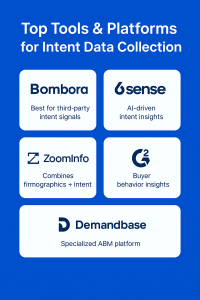Did you know that nearly 70% of B2B marketers now rely on intent data to prioritize accounts and personalize outreach (Statista, 2024)? As we step into 2025, intent data has evolved from a “nice-to-have” tool to the backbone of Account-Based Marketing (ABM) strategies.
With buying cycles getting longer and decision-making committees growing in size, B2B intent data helps you identify in-market accounts early, tailor campaigns to their specific needs, and align sales and marketing for maximum impact.
1. What is B2B Intent Data?
B2B intent data is behavioral information that signals when a company is actively researching a product, service, or solution online. Examples include:
- Reading whitepapers or eBooks
- Searching for competitor comparisons
- Attending webinars or online events
For ABM programs, intent data allows marketers to spot accounts showing “buying intent” before they even reach out, giving sales teams a head start to engage with high-value prospects.
2. Where Does B2B Intent Data Come From?
Understanding the sources of intent data is critical for creating effective ABM campaigns. Intent signals come from multiple channels:
1. First-Party Data
This is data collected directly from your own platforms:
- Website activity: Which pages visitors are browsing, time spent, and frequency of visits
- Form submissions: Contact forms, gated content downloads, or event registrations
- Email engagement: Opens, clicks, and interactions with newsletters or campaigns
Why it matters: First-party data is the most reliable source since it comes directly from accounts already interacting with your brand.
2. Third-Party Data
Collected from external platforms that track B2B intent across the web:
- Publisher networks and industry websites
- Review and comparison sites
- Display ad impressions or content consumption on partner platforms
Why it matters: Third-party data gives you visibility into accounts that are actively researching your products or competitors outside your direct channels.
3. Firmographic & Technographic Data
These datasets provide context about the companies showing intent:
- Firmographics: Company size, revenue, location, and industry
- Technographics: Technology stack, tools, and platforms the company uses
Why it matters: Knowing the structure and tech environment of a company helps prioritize which accounts to target first.
4. Engagement Data
This captures how accounts interact with your content or industry resources:
- Webinar attendance and session participation
- Content downloads such as whitepapers or case studies
- Social media engagement, such as LinkedIn interactions
Why it matters: Engagement data indicates active interest, allowing marketers to tailor messaging to topics that accounts are most engaged with.
By combining these sources, marketers can create a holistic view of buying intent, prioritize high-value accounts, and personalize campaigns for greater impact.
3. Key Benefits of B2B Intent Data in ABM
Using intent data in ABM provides several advantages:
- Spot in-market accounts early – Engage before competitors do
- Prioritize high-value accounts – Focus on companies most likely to convert
- Personalize campaigns – Tailor messaging to the topics accounts are actively researching
- Shorten sales cycles – Move deals faster with precise insights
- Align sales & marketing – Ensure both teams have shared visibility into buyer intent
4. How to Apply Intent Data in ABM Campaigns
Here’s a step-by-step approach:
- Identify target accounts showing strong intent signals
- Map signals to buyer stages (awareness, consideration, decision)
- Align sales and marketing on which accounts to prioritize
- Create personalized content that matches the exact topics being researched
- Measure engagement and optimize your outreach strategy
5. Top Tools & Platforms for Intent Data Collection
These platforms help marketers collect, analyze, and act on intent data efficiently, integrating seamlessly into ABM workflows.

Conclusion
In 2025, B2B intent data is the fuel behind successful ABM programs. It empowers marketers to detect demand early, create personalized campaigns, and drive measurable ROI. As competition intensifies, intent-driven ABM isn’t just about scaling outreach, it’s about being the first to know, and the first to engage.
I hope you find the above content helpful. For more such informative content, please visit MarketCode.
FAQs
1. What is an example of B2B intent data?
A company downloading multiple case studies on CRM solutions shows buying intent for CRM software.
2. How accurate is B2B intent data?
While not 100% precise, intent data combined with firmographic and technographic insights significantly increases ABM accuracy.
3. What’s the difference between first-party and third-party intent data?
First-party intent data comes from your own channels (website, email), while third-party data comes from external sources like publisher networks.
4. Which tools are best for collecting B2B intent data?
Platforms like Bombora, ZoomInfo, 6sense, and TechTarget are leading options for ABM professionals.




